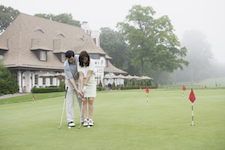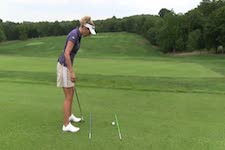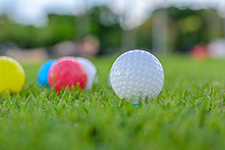HOLE 6:
TAKE GOLF LESSONS
Whether you choose to approach the game of golf as sport, business opportunity or recreational activity, you’ll want to master basic skills, starting with your swing. Though golf may appear pretty simple – use a golf club to advance a ball towards a target – several swing techniques make that happen (and in as few strokes as possible!). You'll want to learn all of them. In this section, you'll receive guidance on choosing a golf instructor and find links to our favorite resources that can help you master the fundamentals of the game.
LESSON LINGO
Golf Lingo
Golf has a language all its own, but it doesn’t have to be intimidating. Once you become familiar with the terms, you'll be more comfortable during lessons and on the course. Below we review terms we covered in Hole #1 and #2, plus a few new ones your instructor will probably use.
Anatomy of a Golf Club
Your instructor will refer to the parts of the golf club during your lessons to help you develop a proper swing technique.
GRIP – The top part of the golf club that you hold with your hands to make a swing. Grips can be sized to fit your hands and they come in differing degrees of "tackiness" for a firm hold on the club.
SHAFT – The "stem" of the club that connects the grip to the club head.
CLUB HEAD – The part of the club used to strike the ball.
HOSEL– The connection between the shaft and club head.
CLUB FACE – The flat part of the club head that is used to make contact with the ball.
SOLE – The bottom of the club head that rests on the ground.
TOE – The outer most part of the club face.
HEEL – The inner most part of the club face.



Position and Posture
Your instructor will spend time working on how you SET UP to, or ADDRESS, the ball, which refers to the proper position the player assumes when preparing to make a stroke.
One of the best ways to develop a consistent golf swing is to make sure that your BALL POSITION, which is the relationship between your body and the ball, is the same each time you take a swing. Your ball position should change gradually with each club because of how your swing changes in response to the different lengths of each club shaft.
When you receive instructions to adjust your STANCE, the instructor is referring to how you position your feet in relation to the TARGET LINE - a set of imaginary parallel lines running from the ball and your feet to your target (think railroad tracks). A golf stance is SQUARE if your toes are on your target line. If you are instructed to OPEN your stance, a right-handed player shifts her feet so the line is pointing left of the target. A CLOSED stance requires an adjustment to the right.



Types of Shots
There are a variety of clubs and swing techniques used to advance the ball. The FULL SWING uses a full range of motion to advance the ball longer distances. When you get closer to the hole and a full swing will overshoot the hole, you'll switch to SHORT GAME shots. (The short game is 50-80 yards or closer to the hole.) CHIPPING and PITCHING are short game shots designed to get the ball onto the green. Once the ball is on the green, you'll use a PUTTING stroke. Putting is the only shot in golf where the ball is not intended to get airborne.
The SWEET SPOT is the ideal area on the club face to strike the ball. You’ll know when you’ve connected with the sweet spot - the ball will fly effortlessly in the air and head in the direction where you aimed. When you're learning, you may not hit the ball flush each time. This is when lessons come in handy; your instructor can help you consistently make solid ball contact.
If you’re a right-handed player and the ball moves severely left to right, it’s called a SLICE. The opposite (right to left) is called a HOOK.
A WHIFF is a complete miss. Don't be embarrassed by it or call even more attention to it by making a big production. Simply put another ball in front of you and try again.
When you hit the top half of the ball and it skims across the ground, it’s called a TOP. When you hit more ground than ball, your shot will pop in the air and fall quickly or dribble a couple of yard. This is called hitting it FAT. The piece of grass that is displaced when you swing a club is called a DIVOT. On the golf course it's proper etiquette to replace the grass or sprinkle sand and seed in the bare spot (seed is typically provided in canisters on your golf cart).







